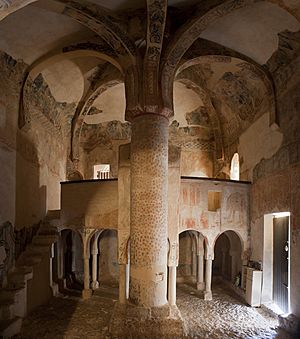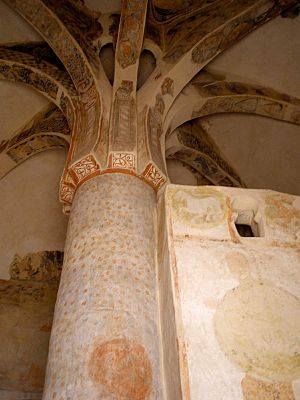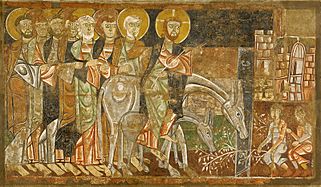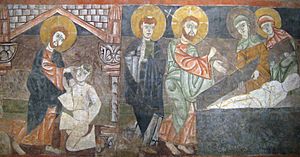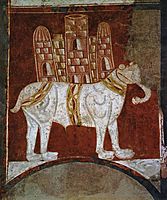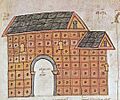San Baudelio de Berlanga facts for kids
The Hermitage of San Baudelio de Berlanga is a small, ancient church built in the early 11th century in the province of Soria, Spain. A hermitage is a quiet place where a religious person, called a hermit, might live and pray. This church is a famous example of Mozarabic architecture, a unique style created by Christians who lived in areas of Spain with Islamic influence.
The church was built around the year 1060, a time when Christian kingdoms were growing stronger in the region. It was built on the border between Christian and Islamic lands. The building is dedicated to a saint named Baudilus, or San Baudelio in Spanish.
Contents
Who Was Saint Baudilus?
The church was named to honor Saint Baudilus, a monk who lived in Nîmes, France, around the 2nd or 3rd century. He became a martyr, which means he died for his religious beliefs.
According to legend, Saint Baudilus was executed with an axe for preaching about his faith. It is said that freshwater springs appeared where he died. The symbols of Saint Baudilus are an axe and a palm tree. The palm tree is a very important symbol for this church, as you will see in its design.
Even today, people make a pilgrimage (a special journey) to a spring near the church on May 20th, his feast day, to honor him. Inside the church, there is a small cave where a hermit may have once lived.
A Unique Building Design
From the outside, the Hermitage of San Baudelio de Berlanga looks like a simple, square-shaped building made of rough stone. But the inside is what makes it so special. Many people say it is one of the most unique churches in all of Spain.
The Stone Palm Tree
When you walk inside, the first thing you see is a huge pillar in the center of the room. This pillar reaches up to the ceiling, and eight arches branch out from the top, like the leaves of a palm tree. These arches connect to the walls, holding up the roof.
It is believed the architect designed this pillar to look like a palm tree on purpose, as a symbol of Saint Baudilus. At the very top of the pillar, there is a small, hidden space. It might have been used to store church treasures or holy relics.
Other Special Features
The church has a gallery, which is like a second-floor balcony, along the west wall. From this gallery, a tiny chapel, called an oratory, sticks out towards the central pillar. It's no bigger than a pulpit and has a window on each side.
A smaller, separate chapel, called the apse, is attached to the east side of the main room. It is reached by walking up four steps through a horseshoe-shaped archway. This style of arch, which looks like the outline of a horseshoe, is a key feature of Mozarabic and Moorish design. The look of the church is similar to famous buildings like the Great Mosque of Córdoba.
The Famous Wall Paintings
The inside of the church was once covered in beautiful Romanesque frescoes, which are paintings made on wet plaster. These paintings, created around the year 1125, told stories from the Bible and showed scenes of everyday life.
Unfortunately, in 1917, the church was declared a national monument, but this did not stop the paintings from being removed. In 1926, most of the frescoes were carefully peeled off the walls and sold to museums around the world. This caused a big scandal in Spain, as many people felt it was a great loss of the country's heritage.
Today, you can see these amazing paintings in museums like The Metropolitan Museum of Art in New York, the Indianapolis Museum of Art, and the Boston Museum of Fine Arts. The Spanish government was able to get some of the paintings back, and they are now in the Prado Museum in Madrid. A few damaged paintings remain inside the church itself.
Paintings of Bible Stories
The artists who painted the walls told many stories from the life of Christ. Some of the scenes that were painted include:
- The Wedding at Cana: Jesus turns water into wine.
- The Temptation of Christ: Jesus is tempted by Satan in the desert.
- Healing the Blind Man: Jesus helps a man to see again.
- The Resurrection of Lazarus: Jesus brings his friend Lazarus back to life.
- The Last Supper: Jesus shares a final meal with his apostles.
- The Three Marys at the Tomb: Women discover that Jesus's tomb is empty after his resurrection.
These paintings were colorful and full of emotion, helping people who could not read to understand the stories of the Bible.
Paintings of Animals and Hunting
What makes the church's art so unusual is that mixed in with the religious scenes are paintings of animals and hunting. These are called secular paintings because they are not about religion.
Some of the fascinating secular paintings include:
- A Hunter: A man with a crossbow is shown hunting a deer.
- A Falconer: A man holds a falcon, which was a noble sport in the Middle Ages.
- An Elephant: A painting of an elephant carries a castle on its back. The artist had probably never seen a real elephant, so it looks a bit strange.
- A Camel: This painting shows a camel, which was an exotic animal in Spain at the time.
- Other Animals: There are also paintings of bears, dogs, and hares.
These paintings give us a glimpse into what life was like in Spain 900 years ago, showing the mix of Christian and Islamic cultures.
Images for kids
See also
 In Spanish: Ermita de San Baudelio de Berlanga para niños
In Spanish: Ermita de San Baudelio de Berlanga para niños



